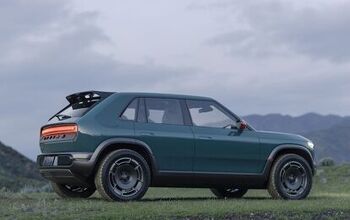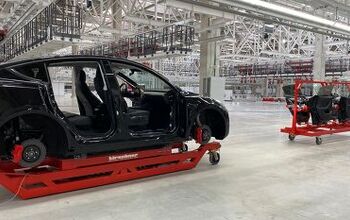The Blame Game: Driver Fingers Autosteer as Cop Car Collision Cause

This won’t help our Pravda rating.
Police in Laguna Beach, California told the “media” that the driver of a Tesla Model S that collided with a parked Ford Police Interceptor Utility on Tuesday was operating in Autopilot mode. At least, that’s the driver’s claim.
Images released by Laguna Beach PD reveal a somewhat glancing rear impact, as it seems the police cruiser only slightly intruded into the driving lane. The cruiser, then unoccupied, was totalled, while the insurance company — if past collisions are any indicator — will probably declare the Tesla a write-off.
Right now, there’s no confirmation that autosteer and traffic-aware cruise control was enabled on the Tesla.
If this turns out to be a false claim, you’ll see an update here. If it isn’t, well, you’ll still read about it here. As it stands, we don’t know any details of what occurred inside the vehicle leading up to the collision, how fast it was travelling, or whether the driver received any visual or audible warnings. Tesla hasn’t released a data-filled blog post (as it sometimes does when Autopilot pops up negatively in the news).
Sgt Jim Cota, Laguna Beach PD’s public information officer, claims the Tesla driver received minor lacerations from his glasses in the collision.
When contacted by The Guardian, a Tesla spokeswoman repeated the automaker’s safety instructions for the proper use of Autopilot features. “When using autopilot, drivers are continuously reminded of their responsibility to keep their hands on the wheel and maintain control of the vehicle at all times,” she said. “Tesla has always been clear that autopilot doesn’t make the car impervious to all accidents, and before a driver can use autopilot, they must accept a dialogue box which states that ‘autopilot is designed for use on highways that have a center divider and clear lane markings’.”
Despite boastful pronouncements about Autopilot’s abilities in its infancy, Tesla maintains that drivers should only enable the features on proper, divided roadways. Drivers must also remain alert and keep their hands on the wheel. Still, the word “Autopilot” remains in use (much to the consternation of road safety groups), and videos of misuse are a click away on the internet.
This crash brings to mind a recent rear-end collision in Utah that also involved a stopped municipal vehicle. In that incident, a Model S maintained a steady cruise speed as it approached a red light, colliding with a fire truck at 60 mph. Investigations are underway to pinpoint why the car’s forward-facing cameras and radar failed to detect the obstacle and warn the driver.
[Images: Laguna Beach Police Department]

More by Steph Willems
Latest Car Reviews
Read moreLatest Product Reviews
Read moreRecent Comments
- SCE to AUX Norway is in Europe, and Tesla is an American automaker - no problems there.I wouldn't use Ford as the bellwether.https://www.reuters.com/business/autos-transportation/tesla-extends-lead-norway-evs-take-record-82-market-share-2024-01-02/https://elbil.no/english/norwegian-ev-policy/
- Steve Biro If the U.S. government wants to talk about banning all connected cars - or at least the collection and sharing of information from said vehicles - I’m all ears. Otherwise, don’t waste my time.
- Ajla Both parties are in favor of banning Chinese vehicles so I don't see how it won't happen in the next year.
- Add Lightness I don't waste a lot of time watching nothing much happening by watching the YouTube 6 minute highlights.
- MrIcky from my rental fleet experience, id rather drive one of these than a camry.



































Comments
Join the conversation
The fact that the "overweight police" vehicle was 'totaled' and the "wouldn't exist without taxpayer money" vehicle is a 'write off' is a bigger economic problem for society than what the idiot driver of the government vehicle did or did not do prior to the crash.
Regarding the Utah collision where a Tesla ran into the rear of a stationary fire truck, the account I read said that the Tesla had been following another car. That car pulled out into the left lane — at the last moment, or a pretty late moment? — to go around the fire truck, at which point the Tesla continued straight on and ran into the stopped fire truck at speed. I've seen no statement as to how long the Tesla had to detect and process the newly revealed hazard. The Tesla's forward collision avoidance system, however good or bad it may be, only reacts to the vehicle directly in front, and can't look beyond that as an alert human driver would. This is also true of other makes of semi-autonomous driving systems.